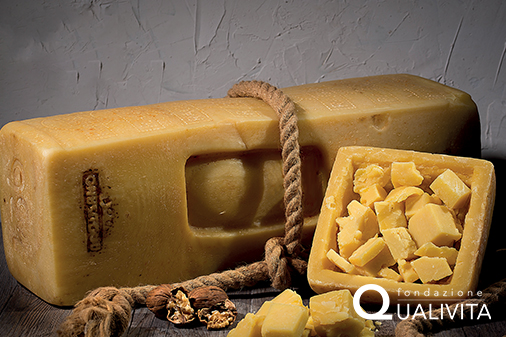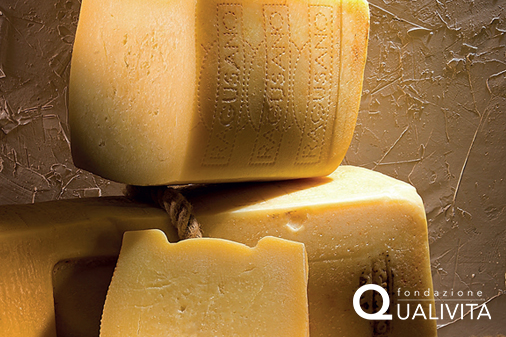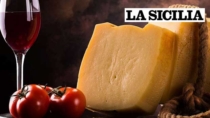Description
Ragusano PDO is a spun paste cheese produced with raw whole cow’s milk.
Production Area
The production area of Ragusano PDO is within the entire territory of the Province of Ragusa and the municipalities of Noto, Palazzolo Acreide and Rosolini in the Province of Syracuse, in the Sicily region.
Production Method
The milk is curdled with lamb and/or kid rennet. The curd is then broken after about 60-80 minutes, in order to stimulate the expulsion of the whey. The curd is first cooked at a temperature of 80 °C, which leads to the formation of grains the size of a grain of rice. The whey is expelled and the paste is heated with second cheese whey, the liquid obtained from the processing of ricotta, after which it is covered with a cloth and left to rest for 85 minutes. After being left to dry for about 20 hours, the cheese is cut into slices, covered with hot water for several minutes, and then rolled into a ball that is then shaped into a parallelogram composed of squares. The cheeses are then salted in brine, after which they are tied together in pairs and hung over special frames and left to ripen in ventilated rooms, at a temperature of 14-16 °C; cheeses that will be left to ripen for a longer period of time are basted with oil. The cheese can also be smoked, only using traditional natural methods.
Appearance and Flavour
Ragusano PDO has a parallelogram shape divided into squares, with rounded corners. The rind is firm, smooth and thin (maximum 4 mm thick), with a colour ranging from golden yellow to straw-yellow and brown in the more mature grating cheeses. The cheese is white to straw-yellow, firm, with a few eyes and some cracks emerging with aging. It has a pleasant, characteristic aroma and a sweet, delicate and overall palatable flavour. The taste is only slightly piquant early on in the ripening process, but this gets stronger over time, becoming flavoursome and piquant in the grating cheese.
History
Ragusano PDO is one of the oldest Sicilian cheeses, around which a flourishing trade arose, one that was already thriving outside the island by the 16th century. There are various historical sources that document the importance of this cheese, such as Da Ferdinando il Cattolico a Carlo V. L’esperienza siciliana (1475-1525), written by Carmelo Trasselli in 1515. The work refers to the tax exemption for Caciocavallo cheeses, probably given this name due to the particular ripening method: hung “a cavallo” over the frames.
Gastronomy
Ragusano PDO is best kept wrapped in its original packaging or in aluminium foil, in the least cold compartment of the refrigerator, inside a glass or plastic container. It should be taken out of the refrigerator about one hour before serving, removing the wrapping to allow it to fully regain its flavour and aroma. The freshest cheese is excellent as a table cheese, and thanks to its versatility it can also be used as an ingredient in many Sicilian recipes. Ragusano PDO that is aged for more than 12 months is ideal for grating.
Marketing
The product is marketed as Ragusano PDO. It is sold year-round, whole, in pieces and in pre-packed slices. Each cheese must bear the product logo, the fire-branded mark with the name Ragusano, the product identification number and the PDO mark, which can be followed by the wording “affumicato” if the cheese has been smoked.
Distinctive Features
The dairy processes used for the production of Ragusano PDO are carried out with wooden or tin copper utensils and equipment, which contributes to the distinctive organoleptic properties of the cheese. These utensils include the ruotula, a wooden stick with a spoon shaped end, which is used to break the curd.

















